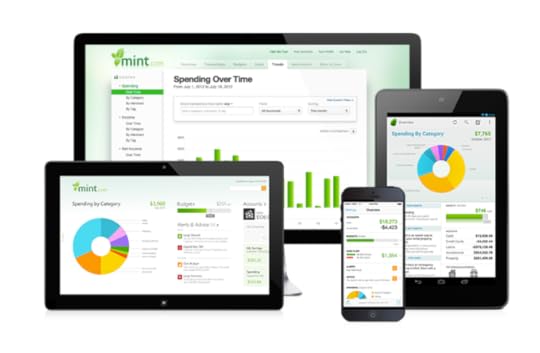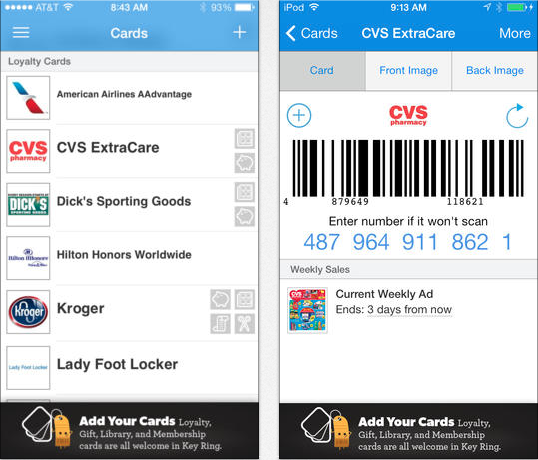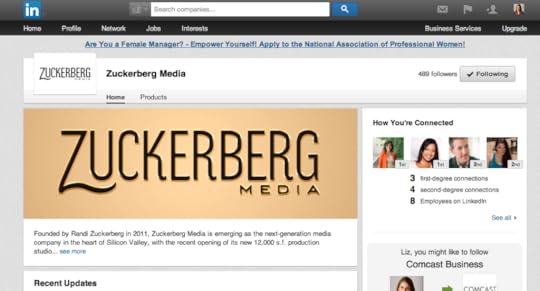Randi Zuckerberg's Blog, page 51
February 24, 2014
Quick And Easy Tech Solutions To Help Squash Marital Squabbles
Marriage produces its share of happiness, but it also supplies its share of arguments, as well – and very often the same ones. Whether you and your spouse don’t agree on how much to set aside in savings, where to cut back to save on bills, who does more housework, or sincere ways to boost affection, there are different technologies out there that could spare you from these minor debacles – and possibly save your marriage.
Try these services and see how your marriage and family life improves:
1. Mint.com (free): Money is often at the core of many arguments couples have, and Mint.com is one of the best ways to resolve debates over finances. Mint looks at your different bank accounts and credit cards and allows you to set a budget that is right for your family. It also shows you where the money is going to keep you on track to reach your financial goals, and illuminates where you may need to make a change. If you keep separate accounts for some expenses, the PayPal app is a great way to easily transfer money to each other so you don’t have to worry about paying each other back with a check.
 2. Pinterest (free): More and more couples have been using Pinterest as a way to peek into what their spouse enjoys. Looking at your wife’s board is a great way to see what gifts she is hoping to receive, a recipe she wants to try, or a special location she wants to visit. Perfect for planning a surprise or buying gifts.
2. Pinterest (free): More and more couples have been using Pinterest as a way to peek into what their spouse enjoys. Looking at your wife’s board is a great way to see what gifts she is hoping to receive, a recipe she wants to try, or a special location she wants to visit. Perfect for planning a surprise or buying gifts.
3. Spotify (Free or $9.99/ month for Spotify Premium): Learn to collaborate and communicate out of the box by creating a collaborative playlist with your partner – both spouses can add their favorite and most intimate tracks to the playlist, and can listen to it together when they need to feel a little emotional, musical affection. It’s also a way to feel close when you’re apart– by listening to music your partner picked out for you. Consider it the updated version of the mixed tape. (This also works for groups of friends or family members who are apart!)
4. Nest Thermostat ($249): Arguing over heating and electric bills during the cold and hot months is a very common dispute among households. With the Nest Thermostat, all you need to do is change the temperature for a few days to teach Nest what you like, and after that it learns about you and your home and starts activating features to save you more energy – and ultimately money. Since it learns automatically, you don’t need to fight every day about the temperature.
Posted on 2/24/2014



 by
by 
The post Quick And Easy Tech Solutions To Help Squash Marital Squabbles appeared first on Dot Complicated.
February 23, 2014
NekNominate: The Deadly Social Media Drinking Game
While we try to keep things positive and upbeat here at Dot Complicated, we also strive to keep you in-the-know on trends that may be keeping parents across the nation up at night. Around the world, teens and young adults have found a new way to coerce each other into drinking large quantities of alcohol– through videos on social media sites.
NekNominate involves someone posting a video of themselves drinking a large amount of alcohol in an outrageous way. This could be in the shortest amount of time, wearing a costume, or simply drinking the most they can physically consume. Some of the videos show people drinking out of toilet, drinking in their underwear in a public place, or drinking a cocktail mixed with dead animals, dog food and other nasty things.
Once the feat has been completed, the challenger tags one of their friends in the video or status update to do something even more outrageous. If they refuse, they face public ridicule online. The “game” started in Australia, and quickly jumped to England, where it soon became massively popular. Five young men have already died overseas after drinking deadly concoctions. It’s now gaining ground in the US– I’ve even seen challenge videos on my News Feed.
This trend makes me see red for so many reasons. The dangers of peer pressuring friends to drink is a disturbing trend that has been spotlighted many times, sadly often after a college student or fraternity member passes away from alcohol poisoning. And using social media to perpetrate this lethal behavior is no different than online bullying or bullying in real life. Not to mention that uploading a video of yourself looking like an idiot is a horrible life choice – professionally and personally. Not only will you risk having people you respect (like potential employers!) see it on your profile or shared on another site, but that video also becomes a permanent part of your online identity.
I wanted to share this disturbing game so that parents and mentors can be sure to keep an eye out for this behavior on their children’s social networks. Even if your child hasn’t posted or commented on a video, it’s important to discuss the trend with your children. An easy way to open the conversation without putting them on the spot is to ask if they’ve seen any of their peers participating in or talking about this game. Reinforce the point that participating in any kind of drinking game or peer pressure can have enormous consequences, and putting it on social media only amplifies the damage – your online identity should be a representation of your best self. Think ten times before you participate, and think a hundred times before you post about it.
What do you think? Have you heard of the game?
Posted on 2/23/2014
Written by Liz Wassmann



 by
by 
The post NekNominate: The Deadly Social Media Drinking Game appeared first on Dot Complicated.
February 22, 2014
Are All Your ‘Friends’ Keeping You From Getting Anything Done?
Ever notice how we’ve become good at building connected technology and broadcasting status updates but we struggle staying connected to the people and goals that matter most to us in life?
Looking back it’s easy to see how this happened.
Three hundred years ago, if you decided to be adventurous and build a startup in the Wild West, you said goodbye to your family and friends and community, put your belongings on the back of a few mules, and headed for the Pacific Ocean. From time to time you might write a letter and send it back with a person heading to your community.
You might get one chance for the rest of your life to send a message — and there was no guarantee that it would even get to them.
But then we realize that being connected matters, so we invented covered wagons and created a network of community gossip bolstered by cowboys on fast riding horses called the Pony Express. You could send a status update every day of the week if you wanted to.
Then the railroad made connection even more possible. You could show up in person. Not just send a letter. From one end of the country to the other and back in weeks instead of life times. It made real connection and romance and business possible.
That wasn’t fast enough for for the entrepreneurs of the West. So with a series of dashes and dots they invented a system where telegraph messengers were able to communicate from one into the country to the other in seconds. Then came the telephone where humans could talk ear-to-ear instead of interpreting the dots and dashes coming across the telegraph wire.
Then came conference calling and and direct mail. Your favorite brands could send you handwritten letters selling the wonderment of their latest goods. Catalogs full of shiny products kept you updated on the latest fashions and trendy attire coming soon. Email messaging burst into the scene allowing instantaneous correspondence from your desktop computer. We finally learned how to send shorter messages from a mobile phones called text messages. But that wasn’t good enough so we invented Skype and Twitter and MySpace and Groupon.
Now we can share pictures of our favorite events and our current location, the best deals for buying espresso, and when our favorite celebrity’s new movie is going to launch. And all of it means everything. And that “everything” means absolutely nothing.
We know more about everyone, but we don’t seem to be any happier. Your phone chirps a little louder. You have less livestock to have to manage each morning. But you still don’t feel comfortable and connected to what’s going on around you. Look around. Ask yourself “What’s wrong?”
You’re freaked out that you might have missed something. Concerned that someone else’s status update might be so mind-blowingly awesome that not reading it ten seconds after it is posted will mean a truly horrible, no good, very bad rest of the day for you.
Is it any wonder that you struggle to accomplish audacious feats of wonder? Is it really all that surprising that you find yourself distracted and confused, triple tasking between what’s important, what’s cool, and the people you care about most?
Here are a few things to remember:
1. Ignorance isn’t just bliss, it is very distracting. You probably don’t need to know everything about everyone else — just you.
2. Just because someone else is upset or has an angry opinion doesn’t mean you should let their anger ruin your day too.
3. Have a goal and work towards accomplishing it each day without distraction. You really can’t be obsessed about you and them at the same time.
4. Focus on building connections with people outside of digital devices. Shake hands. Care. Listen. Invest in “human” relationships.
5. Live in the conversation you’re in right now. If it’s not worth you staying focused, don’t have the conversation in the first place.
6. Don’t pretend to be somebody you’re not just because it’s easier to pretend when everything is digital.
7. Don’t be rude with your conversation. Answer the emails people send you. Respond with kindness. No one likes a jerk.
Being connected is a matter the choices you make. A way of life. Don’t let the chirping of your phone steal your dreams. What if your obsession with “not missing out” means that you lose your chance to turn your bold ideas into a raging success? Seems downright silly, doesn’t it?
We’re pretty awesome at inventing ways to connect. You can expect that the whirlwind of connected technology will only accelerate. Maybe it’s time for a reality check. A priority check. A gut check.
Are you connecting to what really matters for you?
Posted on 2/21/2014
Dan Waldschmidt is an international business strategist, speaker, author, and extreme athlete. His consulting firm solves complex marketing and business strategy problems for savvy companies all over the world. Dow Jones calls his Edgy Conversations blog one of the top sales sites on the internet. He’s been profiled in Business Week, INC Magazine, BBC, Fox News, The Today Show, and Business Insider, has been the featured guest on dozens of radio programs, and has published hundreds of articles on progressive business strategy. He is author of EDGY Conversations: How Ordinary People Achieve Outrageous Success.



 by
by 
The post Are All Your ‘Friends’ Keeping You From Getting Anything Done? appeared first on Dot Complicated.
February 21, 2014
10 Mini-Challenges for Unplugging This Weekend
Weekends are always a great opportunity to practice some mindfulness around how we use technology. People often ask us for easy tips on unplugging, so we listed are few mini challenges you can try over the weekend. Some of you will find these super easy (“I do this all the time anyway!”), and others will struggle to remember the age before smartphones, when these challenges were non-issues.
In any case, we hope you’ll join us. Ready? Set? Unplug!
1. Temporarily delete your top three most-used apps on your phone, and go the whole weekend without them. For me, that would be Facebook, Spotify, and Instagram. Don’t worry – you can reinstall them on Sunday night!
2. Eat a meal alone – and that means completely alone, without checking your devices once.
3. Do something outrageously fun with friends or family, and resist the urge to document it with photos or status updates.
4. Leave your phone and tablet in another room before going to bed, and see if you can make it past breakfast the next day without checking them.
5. Take a chance and eat at a new restaurant you haven’t Yelped or looked up online. Form your own opinions completely independent of strangers’ reviews.
6. You know that friend you’ve been meaning to text or message back? Pick up the phone to catch up instead.
7. Memorize driving directions to an unfamiliar place before hopping in the car, instead of relying on your GPS or navigation app. You might get a little lost, but I’m sure you’ll find your way!
8. If you’re feeling ambitious, go a full day (or full weekend) unplugged – with your laptop and devices powered off. This includes your TV!
9. Let your red Facebook, Twitter, and Instagram notifications accumulate. Though they’ll beg for your attention, don’t click to check them until the end of the weekend.
10. Push yourself to spend idle waiting time – in line at the store, at a stoplight, during a commercial – brainstorming ideas for work or your next passion project, instead of checking your phone.
How many mini-challenges did you attempt? How many do you already do regularly? Tell us in the comments below!
Posted on 2/21/2014
Written by Ashmi Pathela



 by
by 
The post 10 Mini-Challenges for Unplugging This Weekend appeared first on Dot Complicated.
February 20, 2014
You Have To Do The Hard Things
You have to make the call you’re afraid to make.
You have to get up earlier than you want to get up.
You have to give more than you get in return right away.
You have to care more about others than they care about you.
You have to fight when you are already injured, bloody, and sore.
You have to feel unsure and insecure when playing it safe seems smarter.
You have to lead when no one else is following you yet.
You have to invest in yourself even though no one else is.
You have to look like a fool while you’re looking for answers you don’t have.
You have to grind out the details when it’s easier to shrug them off.
You have to deliver results when making excuses is an option.
You have to search for your own explanations even when you’re told to accept the “facts”.
You have to make mistakes and look like an idiot.
You have try and fail and try again.
You have to run faster even though you’re out of breath.
You have to be kind to people who have been cruel to you.
You have to meet deadlines that are unreasonable and deliver results that are unparalleled.
You have to be accountable for your actions even when things go wrong.
You have to keep moving towards where you want to be no matter what’s in front of you.
You have to do the hard things.
The things that no one else is doing. The things that scare you. The things that make you wonder how much longer you can hold on.
Those are the things that define you. Those are the things that make the difference between living a life of mediocrity or outrageous success.
The hard things are the easiest things to avoid. To excuse away. To pretend like they don’t apply to you.
The simple truth about how ordinary people accomplish outrageous feats of success is that they do the hard things that smarter, wealthier, more qualified people don’t have the courage — or desperation — to do.
Do the hard things. You might be surprised at how amazing you really are.
Dan Waldschmidt is an international business strategist, speaker, author, and extreme athlete. His consulting firm solves complex marketing and business strategy problems for savvy companies all over the world. Dow Jones calls his Edgy Conversations blog one of the top sales sites on the internet. He’s been profiled in Business Week, INC Magazine, BBC, Fox News, The Today Show, and Business Insider, has been the featured guest on dozens of radio programs, and has published hundreds of articles on progressive business strategy. He is author of EDGY Conversations: How Ordinary People Achieve Outrageous Success.



 by
by 
The post You Have To Do The Hard Things appeared first on Dot Complicated.
Sometimes, Being A Good Mom Means Giving Up A Little Control
Before I was a mom, I thought I could control most everything in my life, and for the most part I did. I was the lead in the school play, the president of student council, and the girlfriend to the dreamy boy who sat in front of me in math. But “luck is the residue of design,” as baseball pioneer, Branch Rickey, observed. “Things worthwhile generally don’t just happen.” With every achievement, I had failure, tears, and lots of hard work along the way. I cried when my name was not on the casting list many times before I got the lead, I lost more than one election before winning the “big one” in high school, and I ached for the boy who sat in front me in math for a year before he asked me on my first date.
Before I was a mom, I did not know the frustration, pain, and exhilaration that comes when you cannot control major parts of your life, despite trying obsessively, such as when I would become pregnant, whether I would successfully give birth, and at what cost. It rocked my world to discover that I could not orchestrate these events in my life, and perhaps this was the beginning of my preparation for Motherhood.
What I have learned in my fleeting eleven years as a mom is that the act of letting my children map out their own paths, even when it means failure, does not come easily. Yet they too need to learn, through hard work, practice, and failure, how to navigate their own lives, and to develop resilience for when things don’t go their way. This is in part how little BLUEPRINT, a company I created to empower children, came about. Many years of research on child development and brain science, and motherhood itself, have taught me a simple, but fundamental concept: Children need to practice making their own plans from the earliest ages, which often means that parents must relinquish some control.
When children practice planning, it is like learning to ride a bike without falling over every time you hit a bump in the road. We as parents are not always there to steer the bike, but children need early and regular practice to learn a feel for the road. From anything as simple as a plan for getting by on the playground to a plan as profound as mourning the death of a grandparent, children need to be empowered to create their own plans. It is through this practice of planning that children learn effectively to L.E.A.D.: to integrate Logic and Emotions to Analyze and make Decisions.
The brain’s executive function – essentially, the ability to control behavior, to plan effectively, and to behave proactively (instead of responsively) – is rooted in the top part of the brain, but requires concerted action among the brain’s key systems. Combining logic, emotion, analysis, and decision-making to develop plans integrates these key systems of the brain, thereby strengthening executive function through practice. Executive function is now widely viewed as a strong predictor of children’s success in school and in life, beyond any IQ score or standardized test results.
And so, when I find myself about to dictate to my daughter that she cannot sign up to post photographs of herself on Instagram, I stop and take a different approach. Instead, I ask her to write me an essay on her plan for using Instagram, explaining her understanding of the dangers, and why she thinks she is ready for this responsibility. Maybe this time her essay will carry the day, and maybe it won’t. But regardless, she will learn from trying. And, if her request is granted, she will have developed a proactive plan to protect herself by acting responsibly. By teaching anticipatory behavior, but not handing her the plan, she is developing the skills to successfully navigate situations independently.
Similarly, for my younger ones, when I lose patience at bedtime because I know how critical sleep is to my children’s growth and brain development, I remind myself that they need to be a part of the bedtime plan. I take a step back and help them (1) learn facts about the importance of sleep; (2) examine how they feel when their body is tired, why I am impatient when they don’t go to bed, and what is hard about saying goodnight; (3) analyze possibilities for a bedtime plan, including writing or drawing in a journal, learning calming techniques such as a bedtime chat with breathing exercises, or reading together for a set time before bed; and (4) decide on their own plan for bedtime. It may have been simpler to announce the rules and enforce them or more fun to stay up and cuddle together until my children fall asleep (I’ve tried both). But by empowering children to create their own plans, we give them a sense of control, challenge them to take responsibility for achieving a goal, and strengthen their brains in the process.
The beauty of teaching children to develop their own plans is that when there is failure and hardship along the way, that too becomes part of the intentional journey of growth. But sometimes it’s hard to be an observer from the sidelines. The part of Motherhood that involves letting go of control is something to which I am still adjusting. I confessed to a close friend recently that I don’t want to be THAT kind of controlling mother-in-law one day, who is always giving unsolicited parenting advice.
“Oh don’t worry,” she reassured me, “you will.”
Katherine Eskovitz began her career as a trial lawyer. A graduate of Yale Law School and Cornell University, Katherine practiced law for seventeen years as a federal prosecutor and partner in a national law firm before turning her courtroom skills, and experience as a former speechwriter, to writing for a new audience: children. Katherine’s Have a Plan Books, available at www.littleBLUEPRINT.com, are the result of years of research on child development and brain science, writing and collaboration with experts, and passion for photography. A native New Yorker, Katherine lives in Santa Monica, California with her husband and three children.



 by
by 
The post Sometimes, Being A Good Mom Means Giving Up A Little Control appeared first on Dot Complicated.
February 19, 2014
What I Saw When I Finally Looked Up From My Phone
I only have a handful of pictures from our family vacation last week. We escaped the “Snowmageddon” that dumped more than seventeen inches on the Northeast for what is now our annual trek to Florida in February. The weather was as close to perfect as we could have hoped for, the sunsets were spectacular, both of my children had a wonderful time, and my husband and I finally got a chance to reconnect away from the rushed and harried life we live at home.
And I have almost nothing to show for it.
It’s not that I was making a conscious choice not to take pictures, it was that I was making a conscious effort not to post them on Instagram, or put them up on Facebook, or tweet them. I was taking a much-needed break from social media – something that is neither original nor uncommon these days. Some people have “Digital Sabbaths” rules of no tech at the dinner table, or after a certain time of day – for me this felt right…and necessary.
The fact that by the third day of our trip, I turned to my husband and said “I haven’t made you pose for a single ‘selfie’ with me yet!” and was somewhat shocked by it, said a lot to me. It made me ponder the reason and the audience I take all of those pictures for. I am somewhat ashamed to admit that I realized that the hundreds of photos I usually take, and make my children and husband and – well, chickens I roast and pies that I bake – pose for, are not for us. They are for them. Those people out there that are also spending a lot of their time looking down at the phones they have glued to their hands.
The time I spend with those hundreds of photos I cull through trying to find the one that looks the best, then searching for the perfect filter to further enhance it, writing the witty/sarcastic/touching caption that is most fitting – while I am going through all of those steps for these photos I have taken, I am looking down. I am missing the rest of it. I am impatient and only half-listening to my children or my husband in the moments after the photos have been taken while I go through this process. That’s not even counting the embarrassingly high number of times that I repeatedly go back to check how many “likes” and comments the photos have garnered and by whom. It’s self-centered, and insecurity-based, and shameful to admit…but it’s true.

The one family photo we have from the trip.
I not only suffer from the widely discussed FOMO (or Fear of Missing Out), but I apparently also suffer from the much lesser known conditions FOBI (Fear of Becoming Irrelevant) and FOBF (Fear of Being Forgotten). These conditions are not widely discussed, mostly because I just made them up (the latter of the two clearly needs some work based on the awkward pronunciation challenges it faces).
There were many things I missed while I was away – most notably a monthly Writers’ Salon at a friend’s home that I look forward to. Adding insult to injury, the writer that was featured this time was someone whose work I really respect and whom I have gotten to know personally. There were plenty of other writers and friends that I knew that would be there that I either hadn’t seen in a while, or had never had the opportunity to meet in person as of yet.
And I was disappointed to be missing that, among other things. And I took this break from Social Media partially so I wouldn’t feel badly about the things I was missing while I was gone. And when I stopped looking down at my phone to see what I was missing, I looked up – and saw what I was missing.
Instead of grabbing my phone to put the funny quip my husband had just said onto Facebook, I laughed until tears sprang out of the corners of my eyes. Instead of Instagramming photos of my kids digging in the sand together, I dug moats and looked for shells with them. Instead of using my phone to shield the sun from my eyes as I scrolled through tweets and Facebook updates, I put my phone away, silenced the ringer, and simply closed my eyes – listening to the sounds of the bay (and the woman incessantly talking in a rather shrill voice about the horrible weather in the Southeast and how many times it had snowed in Texas in the past twenty years – I mean, really?? It’s called the “Calm Pool,” lady!).
But I didn’t tweet about her. Instead, my husband and I made little jokes about it and rolled our eyes together. And my children kept saying “mommymommymommy” to me all week, but it wasn’t because I was tuning them out while looking at my phone – it was because I was busy talking and listening to one of them and the other wanted my attention.
I had more patience and less guilt, more fun and less bickering, more connecting and, well, more connecting. The FOBI and FOBF targets I should be worried about were right in front of me.
And there were some pictures taken, a handful of the kids at the beach, a few of me attempting the trapeze (apparently I am afraid of some heights – the guy who assisted me at the top didn’t recognize me the following day until I reminded him that I was the one who kept repeating the mantra that only had one word in it – and it wasn’t “luck”), some stunning sunsets, one or two “selfies” my husband and I eventually did take together, and just one single photo of all four of us together. It is a bit blurry, and some of us have red- eye, and the flash was too bright, and my son’s eyes are half-closed and he is looking away – but we are all smiling. Real, genuine, we-are-enjoying-each-other-and-this-is-not-the-seventh-time-we-are-posing-for-this-picture smiles.
And I am looking up.
Posted on 2/19/2014
Jamie Krug is a writer and stay-at-home-mom with a full-time job as the CMO (Chief Medical Officer) of her family as well as a Huffington Post Contributor. She is the mother to an inquisitive daughter, Parker; and the mischievous-grinned Owen. Her blog www.OurStrokeOfLuck.net tells the story of her family’s day-to-day struggles and triumphs in the wake of the devastating and still largely misunderstood rare diagnosis her son received at birth. She prides (embarrasses?) herself by stating out loud what other mothers may feel but wouldn’t dare say… You can follow Jamie on Facebook, Instagram, and Twitter.



 by
by 
The post What I Saw When I Finally Looked Up From My Phone appeared first on Dot Complicated.
This App Beautifully Consolidates Your Loyalty Cards
I’m a hoarder. A receipt hoarder. Last week my friends saw me pull out my wallet and they almost fell off their chairs. There were receipts spilling out of it every which way; it was quite embarrassing. This past weekend, I made a conscious effort to clean that wallet of mine. And let me tell you, it felt great. Think of it like a detox.
You guys, I had receipts in there from over 6 months ago.
While I was cleaning out my endless supply of receipts, I also came across way too many key ring cards (you know, those plastic cards with SKUs on the back, the ones you get at your grocery, drug store, beauty supply store, and so on). Those little guys were taking up half the space in my wallet. I had between 10 and 15 of them, and while that doesn’t seem like TOO much (a girl likes to get deals while shopping, right?), it made my wallet SO much heavier.
Fast forward to that night while I was lying in bed not being able to sleep, and I discovered KeyRing (free, iPhone, Android); a recently added app to my iPhone that has become a fast favorite of mine. KeyRing allows you to never have to carry one of those little plastic cards ever again. Within minutes, all my little discount cards were uploaded to KeyRing and I was on my way.
KeyRing is very easy to use: Once you download it and sign up (FREE!), you take a picture of the SKU number on each card, KeyRing captures it, you label it, save it, and it’s in your little KeyRing database. You can also take a picture of the front and back of the cards so you have those on file, as well. It’s the same mentality behind the PayPal app, where you can make payments and send and receive money via your phone.
Along with all of those great features, if you type in your zip code, KeyRing finds deals and offers in your area. Perfection, right?
Now that this app has entered my life and my receipts are either in the garbage or filed away, I no longer need to be embarrassed to take out my poor little wallet. It’s a Key Ring Miracle.
Posted on 2/18/2014
Julie Bortnick started in the fashion industry during her college years. She interned at IMG in their models division, while working at Mercedes-Benz fashion week one season. She also spent a few summers at the well-known retailers, Intermix and LF Stores. As soon as she graduated from Lasell College, she dove right into her fashion career. Julie started on the buying team at J.Jill, based in Quincy, MA. Her love of New York City brought her back to work at Oscar de la Renta in their wholesale division. From there, she started working for supermodel and philanthropist Petra Nemcova and her company Be The Light New York, where she is still employed today as Head of Operations. She also continues to run her own fashion and lifestyle blog, from prosecco to plaid, while holding the position of Managing Editor for My Red Glasses.



 by
by 
The post This App Beautifully Consolidates Your Loyalty Cards appeared first on Dot Complicated.
February 18, 2014
Why Your Company Needs A Vibrant LinkedIn Page
LinkedIn is becoming more than a self-promotional, résumé building site. Now, businesses have found a way to be relevant on the social media site too. A social media presence on LinkedIn is different than being connected on other social media sites. LinkedIn has one obvious difference that separates itself from the other social media sites: a professional atmosphere. Users are connecting with like-minded, educated colleagues. A business can use this site to connect with its intended audience, instead of having their message get lost amongst the play-by-play status updates and the unwonted spiritual advice that occurs on other social sites. Here’s how to use this unique audience to promote your business.
1: Spark Attraction
First thing’s first, if your page doesn’t looking exciting, then your page viewers won’t be excited either. Heard this before? That’s because more and more professionals agree on the importance of having engaging graphics that keep a viewer interested in your page for a longer amount of time. Another note about graphics is that they shouldn’t be too distracting or visually unappealing. Basically, keep graphics clean, and use them with a purpose. Use the banner on your LinkedIn page to show graphics that grab your audience’s attention about the product you sell – no sunset pictures if your business sells office supplies. It wouldn’t make sense, right?
2: As a job seeker, seek job seekers
Career centers at every university in the country know the importance of students having a LinkedIn account. They strongly encourage their students to join the professional social site because promoting one’s self on such a site can lead to a job offer. A space such as LinkedIn provides information on interesting companies that a student might never be exposed to otherwise – not every company is posting jobs in the classified section of the newspaper these days. Job seekers can use a business’ LinkedIn to investigate the company. This way they can find information that enables them to make a decision about applying for a job. Having a LinkedIn for you business will be a rallying site for educated job seekers that want to contribute to your operation. Vice versa, a LinkedIn account allows your business to access profiles on educated individuals that you can personally extend a job offer to.
3: Online your expand presence
A LinkedIn profile will expand your business’s online presence. Although you might have a website, a Facebook, a Twitter, an Instagram, and whatever else, LinkedIn connects your viewers to these other sites so that they can learn even more about your company. In LinkedIn’s professional social space, motivated viewers will take an interest and seek out more information on a company through their other sites in order to determine whether they would like to do business with that company. This means potentially more customers and more $$$ for your business.
4: Be a _______ butterfly
There are social features on LinkedIn that some business company pages have not taken a chance on. For instance, the groups feature. By joining a professional group, your business joins a community of like-minded individuals. This connection allows businesses to confer and share ideas among each other. Camaraderie establishes a network that you can begin to rely on. Group members also tend to investigate each other to see who they can partner with. Some members have joined a particular group seeking out a business to hire. Who knows, your business just might get the ticket.
5: Stay alive
To stay relevant, a business company page on LinkedIn needs to consistently post interesting and engaging material. This keeps viewers coming back to your page and reels in new viewers. Without posting regularly, a business fails to communicate with its audience. This can decrease credibility. In order to thrive, it is important to keep your business’s LinkedIn page alive and well.
Taking these steps to vamp your company’s LinkedIn page will help promote your business so that it becomes recognized in a socially professional way. The more presence your company has online, the more you have access to potential customers, educated people that can take care of your company, and social endeavors that build a reliable network of like-minded people. Keep your company page alive and you will increase potential encounters that can only be beneficial.
Posted on 2/18/2013
I am a junior at University of Texas in San Antonio, majoring in public relations, and minoring in business administration. I currently have a public relations internship and can’t wait to break into the “biz.” I’m just a girl trying to balance school with giving my dog, rabbit, and hedgehog equal attention.



 by
by 
The post Why Your Company Needs A Vibrant LinkedIn Page appeared first on Dot Complicated.
February 13, 2014
These Motion Sensors Track Your Devices For You
It seems that the older I get, the less I seem to remember. My photographic memory seemed to disappear minutes after giving birth to my son 3 years ago. My iPhone now functions as my lifeline for just about everything. Without this wonderful device I would never remember anything, get anywhere or be in touch with anyone. Now with that being said, when I lose/misplace my little iPhone a dozen times a day I have a minor panic a dozen times a day. I have a landline, yes people still have them, for the sole reason that I need some other device to call my cell phone. My husband always jokes that he needs to put a tracking device on my phone and keys so that I can find them instantly. Where would I find such a device? Do they even make something like that?
Would it cost a million dollars?
Well in a few short months, my prayers will be answered. No, my mother is not moving in with me; although that would be pretty fabulous, however, the next best thing will be at my fingertips…Sen.seʼs Mother and Motion Cookies.
Sen.seʼs Mother is the head of 4 little motion cookies. Each of these cookies is a multipurpose, autonomous sensor that can connect real-life actions, detect and understand movement, temperature and much more. Each of these independent sensors can travel anywhere, store data for up to 10 days and automatically reports all information back to its Mother. The Mother, like a real-life Mother, analyzes and presents the data as well as gives suggestions through a the storyboard on their app.
Tap any headline on the storyboard for more detail. Like your own mother, you can set reminders via push notifications, text messages, email, phone calls and more.
Some examples of how one can use the Motion Cookies include:
1) Attaching a cookie to the front door to track when it opens. This could alert you if someone was at your home unexpectedly or to make sure your child got home at a stated time.
2) Attaching a cookie to a cell phone/keys/wallet and track where you tend to “lose”/leave your things.
3) One could use a cookie to track your steps every day
4) One could attach a cookie to your Keurig to track how many coffees you drink daily and how many k-cups you have used so that you can order new ones before you run out.
Sen.seʼs Mother begins shipping this Spring. For $222 one will receive one Mother and 4 Motion Cookies. Extra cookies are available for purpose but keep in mind that the cookies are like chameleons, so once you fix one problem you can easily reassign the cookie to a new app. Fingers crossed this device and its ever-changing array of apps will be the extra “mom” I have been looking for.
Posted on 2/13/2014
 Written by Veena Goel Crownholm
Written by Veena Goel Crownholm
Veena Goel Crownholm is a UCLA grad and former Miss California. Prior to having her son, she worked in the non-profit field doing special events and program development as well as working as a Program Officer for the Thomas J. Long Foundation. In 2010, after she had her son, she began her career as a Lifestyle Contributor both online and on-air, as well as motivational speaking. She enjoys DIY projects, Thrift Store/Flea Market hunting, Camping and Hiking. She lives in the San Francisco Bay Area with her husband, son and 3 puppies. For more information on Veena please visit www.VeenaGoelCrownholm.com or follow her at: www.TiarastoBabies.com or on twitter @TiarastoBabies.



 by
by 
The post These Motion Sensors Track Your Devices For You appeared first on Dot Complicated.






















